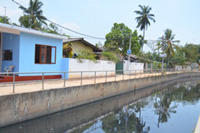Lunawa Environmental Improvement & Community Development Project

Overview
The Lunawa Environmental Improvement & Community Development Project (2003-10), was the first ‘test’ of Sri Lanka’s National Involuntary Resettlement Policy. Today it is touted as an innovative, pro-poor model for infrastructure projects in the developing world, especially relevant for the involuntary resettlement of people from densely populated urban areas.
The Lunawaproject aimed to mitigate the frequent flooding in Colombo, a city in which many areas lieless than six metres abovesea level. The situation is compounded by poor drainage, particularly around the 20 hectare Lunawalake, with its catchment spread over an area close to 7 km2.
Earlier, toxic wastes from about 367 factories, many of them textile dyeing units, used to dump their untreated wastewater into the canals leading to the Lunawa lake, which straddles the municipalities of Mt. Lavinia and Moratuwa in south Colombo. Illegal encroachments and slum-like housing conditions were common.
The technical part of the project was straightforward -- to mitigate frequent floodsin the area byimproving drainage and the canal systems of the Lunawa lake catchment area, including the Lunawa sea outfall, three main drains and secondary drains discharging into the lake.
What the project is known for however is the improvements made in theliving conditionsof the 18,000 households (many of them squatters) residing in the lake’s catchment. This was a multi-modal partnership among relevant government agencies, NGOs, international donors (JAICA was a major donor), municipalities and technical staff from the UN Habitat.
It was challenging to get the enormously diverse population of low-income slum and shanty dwellers as well as lower and upper middle class households to agree to the urban renewal project. It involved getting people to agree to resettle, upgrading the site through improved housing and community areas, together with upgrading drainage infrastructure to revive the Lunawa lake’s eco system.
Of the 18,000 families affected, 883 were entitled for resettlement facilities. Most voluntarily agreed to either be relocated to other areas, or took a cash payment in lieu of their surrendered lands, or agreed to move into project-sponsored housing at the same site.
The entitlement package created was both for those holding legal land ownership titles as well as for persons without legal land ownership. In both cases, a 50 sq. metre house on serviced land, including access to a road, and water and sanitation connection was provided free for those who chose to remain in the area. For those who chose to settle elsewhere, the full replacement cost of the house acquired (approximately LKR 40,00,000 each), was paid, together with a resettlement allowance, and an income restoration grant.
Of the 880 willing participants, 88 households chose to re-settle in four resettlement sites prepared by the project. Here, all basic infrastructures such as access roads, water supply, electricity and sewerage facilities were provided. Likewise, 196 households chose to settle elsewhere, using the resettlement package offered by the project; and 566 households chose to remain at the original site after their plots were ‘regularized’. Only three households objected to the terms of the resettlement package.
The resettlement options gave project-affected families, many for the first time, security of tenure. They now live in their own homes in the resettlement sites, with women as joint owners of property.
Community buy in
The project was designed specifically to mobilize the project-affected. Project authorities acquired 25 acres of private lands (2000 land parcels) for catchment protection and canal and road works. New storm water drains and canals were rehabilitated and new ones built. Housing, amenities and solid waste disposal management systems were constructed as part of the urban renewal project.
Community Development Committees were created and were closely involved in planning the project. NGOs and community workers were roped in to reframe involuntary resettlement as a ‘development opportunity’ for the project affected. Contracts for local operation and maintenance works were given to community organisations to help bolster incomes, and to ensure buy in with project goals.
The project was also designed to create and strengthen abilities of community members to build drains, service roads andcommunity centres within the resettlement sitesand other parts of the project area.Affected people were also involved in working out their entitlement package, while a layered grievance redress mechanism increased transparency in all project transactions.
Likewise, a CommunityInformation Centre located in the project office continues to serve as a one-stop shop for enquiries andcomplaints by the project-affected people. For those opting to resettle outside the designated site, neighbourhood development forums were created to represent the interests of the re-settlers with residents of the host communities.
